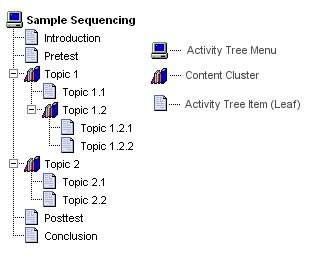
Sequencing overview
SilkRoad Learning conforms to the standards established by the IMS SS Specification that employs a rule-based sequencing model. Applying sequencing rules allows users to design learning activities in terms of clusters of content and apply rules that control the flow and choices for learners as they interact with the content. Content can be organized in many combinations of learning activities. In SilkRoad Learning, learning activities combine to define an eCourse. An eCourse is a collection of one or more content objects that together generates an Activity Tree Menu. The Tree Menu consists of one or more Activity Tree Items (Leaf Items) and/or one or more Content Clusters. Content Clusters may contain one or more Activity Tree Items (Leaf Items) and/or other Content Clusters.
Activity Tree Menu |
The Activity Tree Menu defines a meaningful unit of instruction that presents content to users and evaluates their understanding of the content. |
Content Cluster |
A Content Cluster is an Activity Tree Menu Item with sub-activities. A cluster consists of a single "Parent" item and all its immediate children. Content Clusters may contain combinations of one or more Activity Tree Items (Leaf) or other Content Clusters. Sequencing behavior for the cluster is described by the "Parent" of the cluster. |
Activity Tree Item (Leaf) |
An Activity Tree Item or Leaf is either an individual item in the Activity Tree Menu or a "Child" of a Content Cluster. |
The following sample SilkRoad Learning structure provides an example of these components used in an Activity Tree Menu:

The Activity Tree Menu is used to define the learning activities for users. Together with the Content Clusters and the Leaf Items, sequencing rules can be applied to define how users will access and navigate the content attached to the Activity Tree Items based on the objective status and progress on the activity. Rollup rules applied to content clusters define how status and progress are interpreted by each content cluster or the root content object.
| ©2021 SilkRoad Technology. All rights reserved. |
| Last modified on: 8/27/2020 1:26:53 PM |